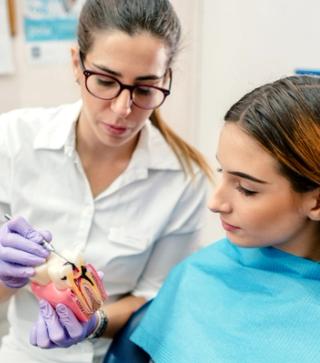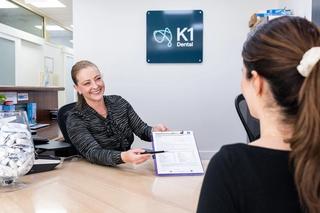Endodontics (root canal) in Toorak
Therapy that can save an existing tooth and save you from future pain.

Our dentists in Toorak will usually do all they can to save an existing tooth because the long-term cost to the patient can be much more affordable than tooth extraction, followed by replacement of the missing tooth. Root canal therapy is just one option that can be used, often in conjunction with dental crowns, to save the tooth, strengthen it and still preserve a natural appearance.
We are experienced in putting nervous or anxious patients at ease, so you can rest assured that you are in safe hands.
What is endodontics and root canal therapy?
Every tooth has a central “living” core made up of nerves and blood vessels. Sometimes this area can get infected. If the infection is left untreated, it can spread to the bone and cause a painful abscess or could even spread to other parts of the body leading to potentially serious complications.
Root canal treatment removes the infected tissue before it can spread. The cavity is then cleaned to ensure there is no bacteria left and filled with specially treated dental material to prevent further infection. The tooth can then be rebuilt or fitted with a crown to match the rest of your teeth.
Sometimes your dentist may recommend a tooth extraction, if the infection has spread too far. Rest assured that at K1 Dental, we will do everything possible to save the affected tooth or teeth, and will discuss all the possible options with you.
Our philosophy towards dental anxiety
We also understand that sometimes the fear is greater than the pain and so all of our dentists are sensitive to patient needs, gentle and really take their time to ensure your comfort. We have designed our dental clinic to have a calm, relaxing atmosphere for the most part without any of the usual smells or sounds of the dentist.
We believe in taking our time over treatment, so the dentists will wait until the topical anaesthetic gel has numbed the area completely before applying the local anaesthetic and this, too, will be given plenty of time to work (or the process repeated, if necessary).
To learn more about out anaesthetic procedure, please visit our Sleep Dentistry page.
Book your appointment at K1 Dental Toorak
Root Canal Therapy at K1 Dental in Melbourne can be performed under a local anaesthetic, to reduce any feelings of distress as much as possible.
Frequently asked questions
A root canal treatment in Australia depends on a number of factors, such as how many canals the tooth has (one canal makes for a simpler and faster procedure than a tooth with four canals), and whether you need additional appointments or sedation.
You may also need to factor in the cost of getting a dental crown, as this is an important follow-up to most root canals and can add an additional cost.
If you need financial assistance for your treatment, we offer an exclusive interest-free payment plan called SmileFund. With SmileFund, you can undergo your dental treatment and pay it off over time.
Yes, absolutely. Anyone who knows the pain of a soft tissue infection or the nerve dying inside the tooth knows just how worthwhile a root canal is. Not only does this treatment rid you of what can be severe dental pain, it also prevents the infection spreading further, and helps to preserve your natural tooth and avoid further dental treatments that you would need to replace it.
A dentist and an Endodontist have the same basic training and skills, but an Endodontist specialises in treatment of the soft tissues in the teeth. That’s why an Endodontist will often perform complicated root canal procedures or other treatments that involve the soft tissue in the tooth.
The most common procedure that an Endodontist performs is a root canal, but they can also fix cracked teeth, place dental implants, do root canal re-treatments, root end surgeries, and anything else relating to the soft tissue inside your tooth.
Sometimes, your dentist may not have the additional training or knowledge they would need in order to perform a treatment. This is most often the case for complicated root canal treatments, but your dentist may also send you to an Endodontist for other procedures, such as fixing an old root canal or placing a dental implant.




